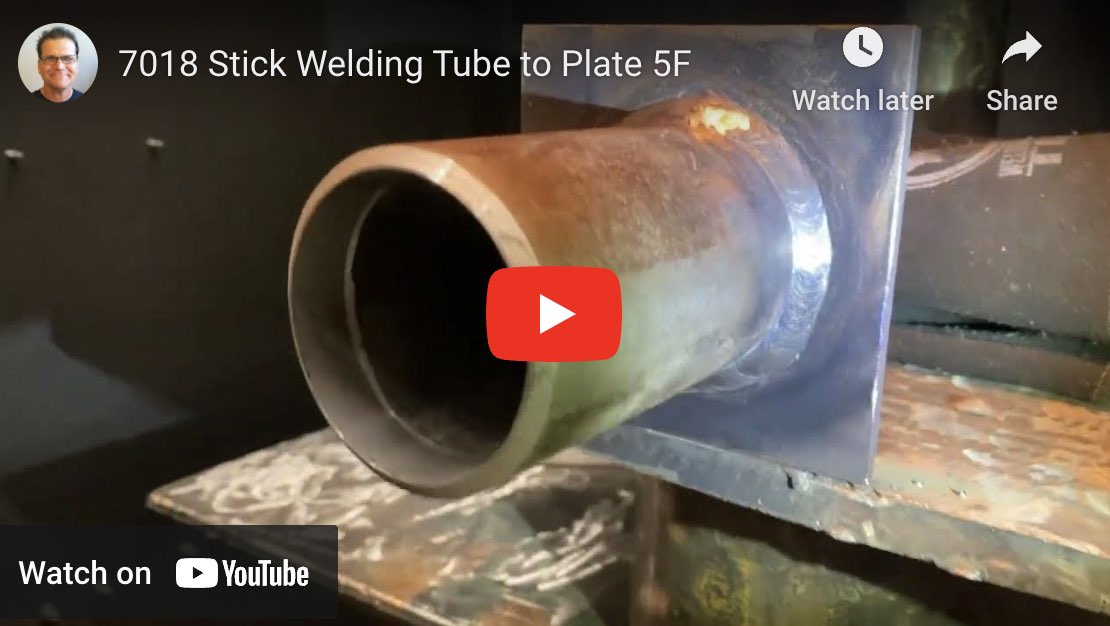How to stick weld 7018
- HOME
- STICK WELDING
- How to Stick Weld 7018
How to stick weld 7018 2F Tee joint
How to stick weld 7018 Overhead 4F tee
Learn faster with our free 7 day test drive at welderskills
If you just searched for "How to stick weld 7018" Here's a step-by-step guide on how to stick weld using a 7018 electrode, written in simple language:
How to Stick Weld with 7018 Electrodes
Step 1: Set up Your welding machine for 7018
- Welding Machine: Make sure it’s set up for stick welding and on DCEP Direct current electrode positive.
- 7018 Electrodes: These are stick electrodes coated with a low hydrogen flux but must be used fresh out of a sealed box or must be kept in a Rod oven in order to maintain the low hydrogen properties.
It's not that 7018 are no good anymore if let out in the open. They just don't comply with codes and specs if left out.
7018 that have not been maintained in a rod oven are no longer low hydrogen but can still be used anywhere you might used another stick rod like 6010, 6011, or 7014.
- Personal Protective Equipment (PPE): Wear a welding helmet, gloves, long-sleeve welding jacket, and safety glasses.
- Ground Clamp and Electrode Holder: double check to make sure the electrode holder aka the stinger is plugged in to the correct port. (all machines are different so check owners manual)
Step 2: Prepare Your Work Area by removing any flammables and make sure you have a fire extinguisher available.
- Clean the Metal: Remove any rust, paint, or dirt from the metal you’ll be welding. Stick welding does a pretty good job of melting thru mill scale but Clean metal welds better.
- Secure the Workpiece: Make sure the metal you’re welding is clamped down or held firmly in place and make sure the ground clamp is connected securely to an area free from paint or coatings.
Step 3: Set Up Your Welding Machine
- Amperage Settings: Set your machine to the correct amperage. For 7018 electrodes, the rule of thumb for a starting amperage in flat or horizontal positions is one amp per one thousandths of electrode diameter.
So for a 3/32" .093" 7018 this is around 93 amps and for a 1/8" =.125" that is around 125 amps, depending on the thickness of the metal.
For vertical uphill welding, reduce amperage by about 10% for a starting amperage and adjust accordingly
- Polarity: Use DC positive (DCEP) for best results with 7018 electrodes.
Step 4: Insert the Electrode
- Load the Electrode: Place the 7018 electrode into the electrode holder.
- Position the Ground Clamp: Attach the ground clamp to the metal you’re welding.
Step 5: Strike an Arc
- Striking the Arc: Tap the tip of the electrode against the metal, like striking a match, to start the arc. This might take a few tries.
- Maintain the Arc: Keep a small gap between the electrode and the metal to maintain the arc. This is called the arc length and should be about the same as the diameter of the electrode or slightly less.
PRO TIP: set amperage hot enough to where the rod won't stick even when you hold a tight arc...then hold a tight arc length.
Step 6: Make the Weld
- Travel Speed: Move the electrode slowly and steadily along the joint. Too fast, and your weld will be too small and you might get undercut; too slow, and you’ll build up too much weld or possibly burn through thin metal.
.
- Weaving Motion: For overhead and vertical uphill welding, a slight weaving can help spread the weld metal evenly.
- Keep a Steady Hand: Try to keep your hand steady and maintain a consistent arc length by finding a way to get comfortable and steady.
Step 7: Finish the Weld
- End the Arc: When you reach the end of the weld, quickly lift the electrode away from the metal to break the arc in s
uch a way as to not drag arc marks outside the weld.
- Chip and Brush: Use a chipping hammer and wire brush to remove slag (the coating that forms on top of the weld).
Step 8: Inspect the Weld
- Check for Defects: Look at your weld to make sure it’s smooth and free of holes, cracks, or other defects. Grind out and reweld defects
Tips for Success
- Angle the Electrode: For flat, horizontal, and overhead welds, hold the electrode at a slight angle (about 5-15 degrees) in the direction of travel. This is also called a drag angle. Electrode angle can be forgiving if current is right and arc length is right.
- Practice: Stick welding takes practice to get right. Don’t get discouraged if your first few welds aren’t perfect.
But don't continue doing the same thing wrong over and over.
Weld a few beads, inspect those beads with a critical eye, re watch a video to see where you need to improve. Then weld another bead.
- Stay Safe: Always keep safety in mind. Use your PPE and make sure your work area is well-ventilated.
By following these steps, you'll be able to stick weld with a 7018 electrode effectively. Keep practicing, and you'll improve your welding skills over time!















